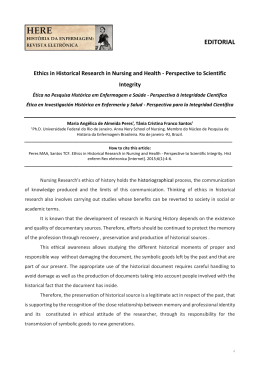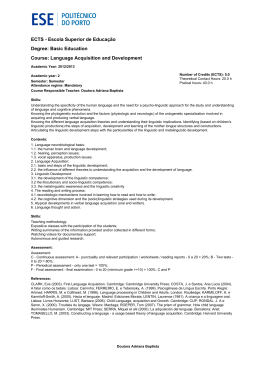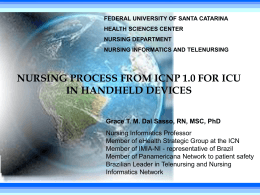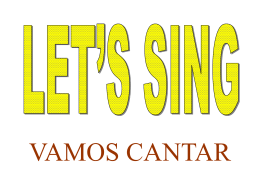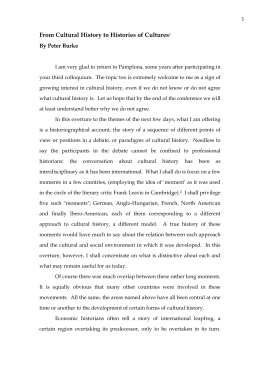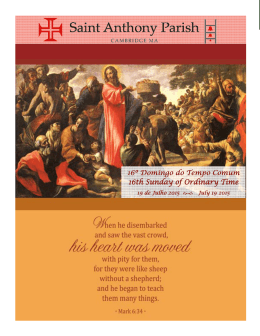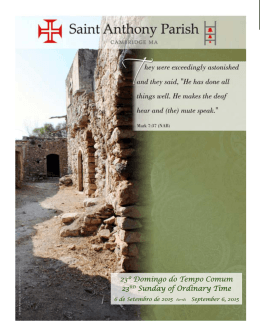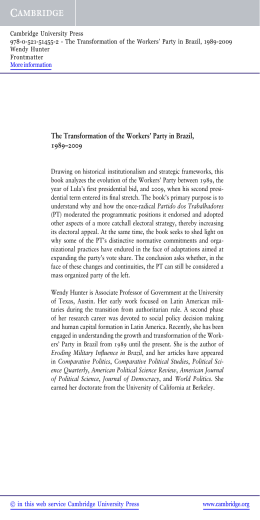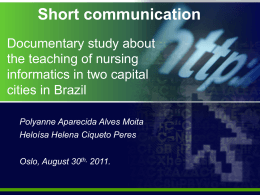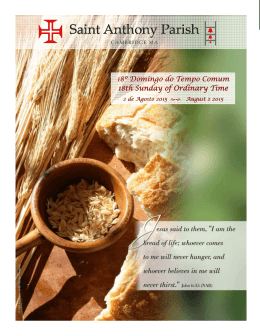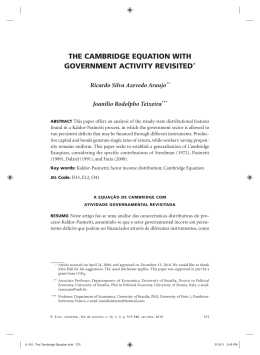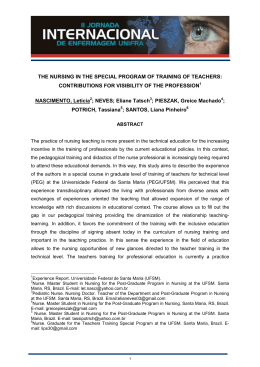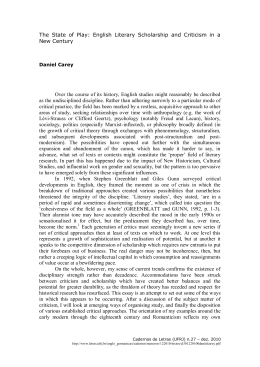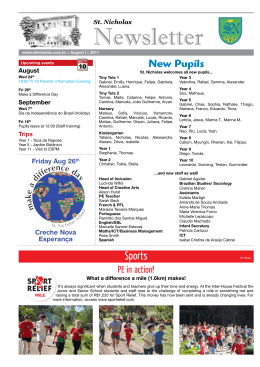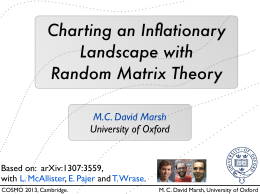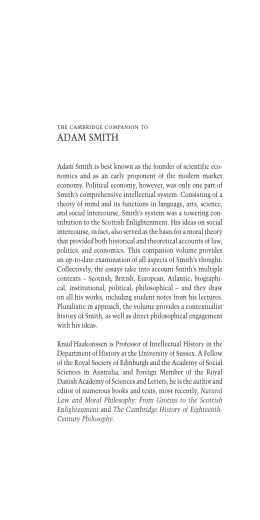ESCOLA SUPERIOR DE ENFERMAGEM DE SÃO JOSÉ DE CLUNY IV CURSO DE INGLÊS TÉCNICO – ÁREA DA SAÚDE Finalidade do Curso: Aumentar o conhecimento e o domínio da língua inglesa na Enfermagem / área da saúde (to improve your knowledge of the English language in the nursing / health areas). PROGRAMA DO CURSO DE INGLÊS TÉCNICO – ÁREA DA ENFERMAGEM / SYLLABUS OF THE ENGLISH TECNICAL COURSE IN THE NURSING AREA This course was designed for students with previous knowledge of the English language (intermediate level or level B1 of the ‘Quadro Europeu Comum de Referência para as Línguas’). Other required common reference levels are A2 and B2. Aims and Competences to be acquired: This course aimed at the mastering and improvement of the knowledge of the English language in the nursing / health areas so as to develop the linguistic and pragmatic competences. At the end of the course each student will be able to: understand oral and written language by improving listening and reading skills when engaged in communicative exchanges in different contexts of the nursing area; produce some oral and written English sentences using different grammatical / lexical structures applied to different nursing contexts, at the hospital, clinic,… or in scientific papers and by roleplaying possible dialogues and by taking notes from oral and written discourse in the nursing area; increase and make use of the knowledge of different grammatical and lexical structures and expressions within the scope of the nursing/health. Syllabus or Course Contents Reading, Writing, Listening and Speaking Skills for Academic Purposes Basic types of texts and language required for professional or academic purposes: E-mail writing; CV, application and recommendation letters; and technical vocabulary for real-life situations in order to allow participants to manage to deal with real life situations. Language skills for Nursing Reading: The nursing profession; Nursing equipment; The elderly and care homes; health and eating habits; medical symptoms. Speaking/Listening: On the ward (different wards); Admitting a patient / Hospital admissions; Accidents and emergencies; Emergency helpline; The human body; Pain, aches and symptoms; Pain relief; Filling a pain chart; Asking questions on a helpline; Transfer to a care home; Calculating ‘BMI’; Blood and Test results;; Making difficult decisions; Hygiene inspection; Vital signs; Anaesthetic procedure; Patient Medication; Monitoring the Patient; Instructions; Assessing a patient; Coma patient; Patient medication; Talking about a patient’s personality and handling demanding patients. Writing: The Hospital Team; in/around the Hospital: nursing equipment and devices in different wards; Accidents and emergencies; Types of patients; Profile of a student nurse; Giving instructions; Monitoring the patient; Patient record form; Patient summary and Information poster / charts; Pain, ache and Symptom report; Describing a procedure; Notices and memos; Job applications; Job interview, CV, application and recommendation letters. Methodology Due to the practical nature of the course, the methodology adopted will focus on the acquisition and development of the four skills (speaking, listening, writing and reading) as well as on vocabulary and grammar. Classes will be structured based on the selected topics which are a part of the syllabus. Active teaching methods will prevail so as to promote the acquisition of linguistic competences. Students will be asked to write brief texts and dialogues during the sessions or as homework assignments. Assessment and Diagnostic or placement tests Although according to the ‘Regulamento Interno da Escola Superior de Enfermagem São José de Cluny’ students may be subject to two types of assessment (continuous assessment in the form of work assignments and exams), students may take a placement or a diagnostic test if they feel it is necessary. Sources: AAVV, Modern English Teacher, Abril de 2004, Nº 2, volume 13 AAVV, International Classification for Nursing Practice, 1.0 / 2.0, International Council of Nurses, Switzerland, Geneve, 2005 / 2010 ALEXANDER, L.G., Longman English Grammar Practice for Intermediate students, Hong Kong, Longman, 1990 Burns, Nancy, Grove, Susan K., The Practice of Nursing Research: Conduct, Critique and Utilization, 4th edition, New York, W. B., Saunders Company 2001 COWTHER, Jonathan (ed), Oxford Guide to British and American Culture, Oxford, Oxford University Press, 2001 DAVIES, Helen, Holmes, Françoise, Dicionário de Inglês para Principiantes, Verbo, 1998 (Usborne publishing) FERNANDES, Mª do Amparo, e Domingues, Mª Emília, Saber Inglês, Porto, Edições ASA, 2001 GAIRNS, R., Redman, S., True to Life – English for Adult Learners, Cambridge, Cambridge University Press (class book and work book), 1987 ---------------, True to Life - Pre-intermediate- Personal Study Book and Class Book, Cambridge, Cambridge University Press, 1998 GOWER, Roger, Grammar in Practice 1 to 6 – Self-study Grammar Exercises, Cambridge, Cambridge University Press, 2006 GOWER, Roger, Vocabulary in Practice 1 to 6 – Self-study Vocabulary Exercises, Cambridge, Cambridge University Press, 2006 McCARTHY, Michael, and O’Dell, Felicity, English Vocabulary in Use (upper-intermediate and advanced), Cambridge, Cambridge University Press, 1999 MURPHY, Raymond, English Grammar in Use, Cambridge, Cambridge University Press, 1987 Papalia, Diane E., Olds, Sally W., Feldman, D. Ruth, Human Development, 10th edition, New York, McGrawHill International Ed., 2007 REDMAN, Stuart, English Vocabulary in Use (pre-intermediate and intermediate), Cambridge, Cambridge University Press, 1997 SWAN, Michael, and Walter, Catherine, The New Cambridge English Course, 3- Intermediate, Cambridge, Cambridge University Press, 1995 The New Cambridge English Course, 1- Intermediate, Cambridge, Cambridge University Press, 1995 Heinemann Games Series, 1995 English Vocabulary in Use (Intermediate), Cambridge, Cambridge University Press, 2002 Tierney, Alison J., Journal of Advanced Nursing, vol. 67, no.2, February 2011, Wiley-Blackwell VINCE, Michael, First certificate Language Practice – English Grammar and Vocabulary Exercises, Oxford, Macmillian, 2003 WELLMAN, Guy, The Heinemann English Wordbuilder, Bath, Heinemann International, 1992 Professora: Gilda Figueira Coordenadora do Curso: Eugénia Pestana Número de Vagas: 20 (O curso funcionará com um mínimo de 17 alunos). Calendário/Horário: 2014 Março Abril Maio Junho Julho 07*; 21 04; 11 02; 09; 16; 23; 30 06;13; 20; 27 04*** 22 05; 12; 26 03; 10; 17; 24; 31 07;14; 21; 28** Sexta-feira 18:30-20:00 Sábado 09:30-11:00 11:30-13:00 *teste de diagnóstico / Placement test **avaliação escrita (90 min) ***entrega da avaliação Inscrição no Curso: € 10 Propinas: - Estudantes da ESESJC: € 150 (ou 3 mensalidades* de € 50); - Antigos Estudantes da ESESJC: € 165 (ou 3 mensalidades* de € 55); - Outros: € 180 (ou 3 mensalidades* de € 60). *Pagamentos das mensalidades: deverão ser efetuados até dia 08 dos meses de abril, maio e junho Seguro Horário da Secretaria (D. Adília): das 08:00 às 12:00 e das 13:00 às 16:00. Nota: As inscrições terminam quando forem preenchidas as vagas.
Download

